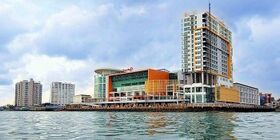Mengakui
| めんがくい | |
|---|---|
 Skyline of the Perdamaian district with the commercial and government center on the south bank of Mengakui. | |
 Flag |
 Coat of arms |
| Location | |
| File:Mengalocatormap.png | |
| Country | |
| Region | Garis Hati Gelap |
| Foundation | ~7220 |
| Government | |
| Type | Staggered democratic |
| Body | City Council |
| Physical | |
| Elevation | 12 m |
| Time zone | UTC-10 |
| Population | |
| Total | 2,163,020 |
| Rank | 6th place |
| Demonym | Mengakui |
Mengakui is the capital city of Garis Hati Gelap, a member state of Sokoku. It has just over 2 million inhabitants in the urban area, making it the second largest city of the state (after Suryanagara) and sixth most populous of the country. In 7650 an urban development plan for 1 million inhabitants was implemented, but the city reached that number already by 7671. Then a new plan was implemented, simply called "one million more". Therefore the city has the characteristics of a planned city, surrounding a historical and colonial core.
History
Mengakui was colonised by the Auresians in the 7220's, at that time it was a rural town with just over 10,000 people. The Auresians used the place as a stronghold for supplies like fresh produce and water. In 7281, the Auresians were driven out by a Hallisian chartered company, which in its turn was taken over after a financial transaction by Livaria in 7305. It became the site of a major Livarian naval base Priznavatsya and as such of strategic importance. This made it the de facto capital of the Livarian colony Harimyr Zemlya. As a city with lesser economic and cultural importance, colonial rule could be executed from here in an efficient way.
For about two centuries, the military stronghold attracted a native population providing food and services to the colonizers, resulting in a successfull coexistence of both cultures within the city, even though both communities lived largely separated in their own areas.
In the early 7600's, when Sokoku was formed as a post-colonial nation, anti-colonial tendencies gained a foothold even in this bastion of Livarian presence. In 7641 Mengakui became the capital of the nationalist post-colonial country Garis Hati, which was declared by Livaria in order to avoid losing the territory to Sokoku. During the six year civil war Mengakui was targeted in a limited way, more through sabotage and precision attacks, resulting in minor damage. This changed in 7647 when the Sokokan supported rebels took over the city and clean sed it from colonial and collaborator influences. But even after the fall of Mengakui, Livaria tried to disturb Sokokan operations repeatedly by bombing and machine-gunning targets in and around the city. While destroying their own abandoned military installations was the main target, heavy bombing of relatively unimportant barracks, but also nearby market places, resulted in much more war damage than throughout the entire civil war.
In 7650, when Garis Hati Gelap's inclusion in Sokoku was accepted by the International Council of Nations (ICoN), the city could start to rebuild based on a city plan for one million inhabitants, with a pre-civil war population of about 325,000. The city became Garis Hati´s primary port, with regular international and domestic shipping connections. It is famous as an essential port of call for the pinisi ships, wooden sailing ships which are in use for regular long-distance trade.
Cityscape
Mengakui hardly has rail infrastructure as backbone for urban transport, but it is using a bus rapid transit system instead despite its two million inhabitants. While a light rail system between a metro and tram was planned and the first corridors had been prepared, the city started growing so fast due to the influx of trading companies and Sokokan government institutions that a quick-fix in the form of road based public transport had to be introduced. In the new city plan for 2 million people a monorail above ground level transportation was proposed instead, but building hasn't started yet due to the high investment costs. As a result, most people are relying on (motorised) bicycles and busses for their daily commute.

While the older, colonial core is on the northern shore of the narrow bay, most people nowadays live in the southern part of the city called Perdamaian. This modern government and business centre was built on the remnants of the destroyed Livarian naval base, directly adjacent to modern port facilities. Surrounding residential dwellings have been industrially manufactured elsewhere and were assembled here, with shops, workshops and restaurants on the ground floor.
The current hinterland of Mengakui is formed by the Hutan Lindung Sungai Wahi, a natural rainforest habitat near the city on the southern peninsula. Much of the arable land which formed the backbone of the city in the past is now covered with buildings, making the city more dependent of food production further away inland since the rainforest has the wrong soil conditions and topography for agriculture. It has 1,200 types of lowland hardwood trees, covers over 300 hectares (nearly 800 acres) and is known as the "green open space" of the city.
Sights
Mengakui's main attraction is the naval museum on board of the HMS Blåker. This fifth vessel carrying the Blåker name was sunk by the Livarian navy in shallow waters off the coast of Garis Hati Gelap in 7638. After the conflict ended, the ship was salvaged and repaired to serve as a museum vessel. The HMS Blåker played an important part in the liberation of Shuuen four decades prior to its sinking. It was also aboard this vessel that Halland signed a treaty decolonising Bowersland, later becoming the founding member state of Shaaniaah. The historic vessel is docked near the city centre.